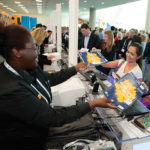
At the World Cup, university students from all over the world compete to create community outreach programs that are judged on a single measure: how successfully they use business concepts to improve the quality of life for people in need.
The nature of his job means that Nasby spends time in a lot of different convention centers, and I asked him if there was anything about them that he found surprising.
Nasby ended up surprising me with his answer: “Their sterile appearance.” Many centers, he pointed out, aren’t doing anything architecturally to create or take advantage of beautiful environments. I was a little taken aback — Nasby and I had been talking about the enormous amount of work being done by SIFE to alleviate poverty and serious social problems in some pretty grim places. I had expected a more utilitarian, no-frills response.
But what Nasby said made perfect sense. The World Cup is about success in raising the quality of life, which includes values like hospitality, relationships, and beauty, as well as efficiency and effectiveness.
A notable convention center where it all comes together, Nasby said, is the Kuala Lumpur Convention Centre in Malaysia, where the 2011 SIFE World Cup was held. The center not only met the World Cup’s physical and technological requirements, “it’s beautiful,” Nasby said. “It overlooks the gardens of Kuala Lumpur and the twin towers.”
“Our event inspires people even if it is in a dumpy ugly building,” Nasby said, ” but I think that when you are in an attractive location — with staff who care and are hospitable to the attendees and to their customers — it enhances the experience.”



